(FSA-NMG-201-02) Recommended Practices for Determination of Extractable Sulfur for Non-Metallic Gasketing Material
Click here for a complimentary copy
This test procedure covers the measurement of water soluble chloride in gasket material. ©2002, 4 Pages.
Click here for a complimentary copy
This test procedure covers the measurement of water soluble fluoride in gasket material. ©2002, 4 Pages.
Click here for a complimentary copy
This test method provides a means of assessing the performance of various non-asbestos gasket materials in saturated steam service under controlled conditions. When Desired, the test may be used as an acceptance/rejection criteria when test conditions are agreed upon by user and supplier. ©2002, 12 Pages.
Click here for a complimentary copy
This technical revision of the standard provides a more comprehensive definition and updated specifications for the industry recommended elastomer compound used in the manufacture of expansion joints installed in high temperature and corrosive flue gas systems. ©2009, 7 Pages.
Click here for a complimentary copy
This standard covers composition and property recommendations for a single layer fluoroplastic/fiberglass fabric belt. Fluoroplastics have been used for flue duct expansion joints because of their outstanding resistance to chemicals and heat. They are particularly effective in applications where condensation and chemical attack are problems, such as sulfuric acid bearing flue gas in coal-fired power plants. ©2007, 6 Pages
Click here for a complimentary copy
This test method enables a relative comparison of the predisposition of a spiral wound gasket to inward buckling. The relative resistance to inward buckling of a spiral wound gasket thereby can be determined. This procedure may be used by supplier and user to establish an acceptance/rejection criteria for spiral wound gaskets, when desired.© 2002, 9 pages.
Click here for a complimentary copy
This standard provides specifications for the above gasket design as applied to flanges for the pipe sizes included in ASME Standard B16.5. Size, class, construction, materials, marking, as well as dimensions are covered. ©2005, 8 pages.
Click here for a complimentary copy
This standard provides specifications for the above gasket design as applied to flanges for the pipe sizes included in ASME Standard B16.47. Size, class, construction, materials, marking, as well as dimensions are covered. ©2006, 16 pages.
Click here for a complimentary copy
This standard provides two test methods for assessing the relative oxidation resistance of flexible graphite material. Method A is a short duration oven screening test. Method B is a more accurate, longer durating procedure under closely controlled environmental conditions based on Thermogravimetric Analysis (TGA). ©2007, 10 Pages.
Click here for a complimentary copy
This test method will establish criteria for determining standard loading constants that are referenced in current ASME pressure vessel design. ©2011, 15 Pages.
Click here for a complimentary copy
This specification covers the hydrotesting and/or vacuum testing on non-metallic flanged expansion joints. ©2006, 9 Pages
Click here for a complimentary copy
This specification covers the installation, maintenance and storage of non-metallic expansion joints. ©2006, 7 Pages.
Click here for a complimentary copy
This Standard provides the typical properties of a range of elastomers most frequently used for tube and cover compounds in the manufacture of piping expansion joints. It is an update of Standard FSA-NMJ-703-99, Specifications of Elastomers Used in Piping Systems Non-Metallic Expansion Joints. Properties listed have shown to provide acceptable performance in applications for which the specific elastomer has been recommended. The Standard is not intended to limit or restrict the use of materials to those listed. Other materials may be developed in the future that will prove to be suitable as well. ©2011, 11 pages.
Click here for a complimentary copy
This test procedure determines the total amount of gap present between sealing surfaces of a damper. ©2010, 3 Pages
Click here for a complimentary copy
This test procedure determines the seal air system performance. ©2010, 3 Pages
Click here for a complimentary copy
©2010, 7 Pages
Click here for a complimentary copy
©2010, 3 Pages
Click here for a complimentary copy




